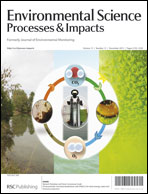High mobilization of arsenic, metals and rare earth elements in seepage waters driven by respiration of old allochthonous organic carbon
Abstract
Metal and metalloid mobilization processes within seepage water are of major concern in a range of water reservoir systems. The mobilization process of arsenic and heavy metals within a dam and sediments of a drinking water reservoir was investigated. Principle component analysis (PCA) on time series data of seepage water showed a clear positive correlation of arsenic with iron and DOC (dissolved organic carbon), and a negative correlation with nitrate due to respiratory processes. A relationship of reductive metal and metalloid mobilization with respiration of old carbon was shown. The system is influenced by sediment layers as well as a recent DOC input from degraded ombrotrophic peatbogs in the catchment area. The isotopic composition (12C, 13C and 14C) of DOC is altered along the path from basin to seepage water, but no significant changes in structural parameters (LC-OCD-OND, FT-IR) could be seen. DIC (dissolved inorganic carbon) in seepage water partly originates from respiratory processes, and a higher relationship of it with sediment carbon than with the DOC inventory of infiltrating water was found. This study revealed the interaction of respiratory processes with metal and metalloid mobilization in sediment water flows. In contrast to the presumption that emerging DOC via respiratory processes mainly controls arsenic and metal mobilization it could be shown that the presence of aged carbon compounds is essential. The findings emphasize the importance of aged organic carbon for DOC, DIC, arsenic and metal turnover.


 Please wait while we load your content...
Please wait while we load your content...